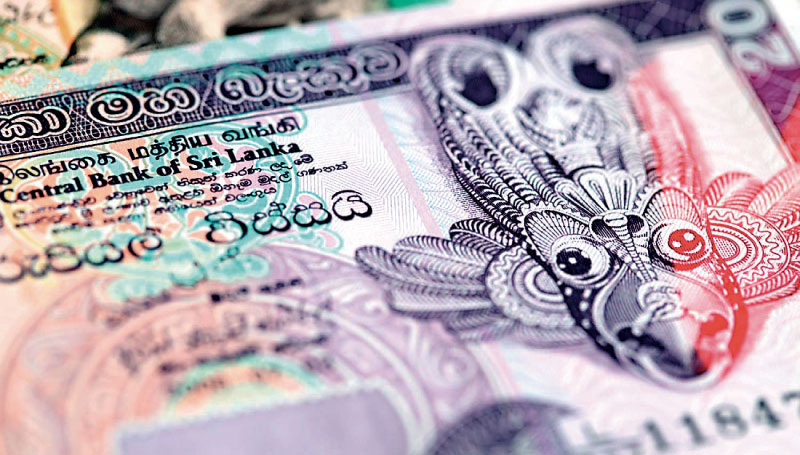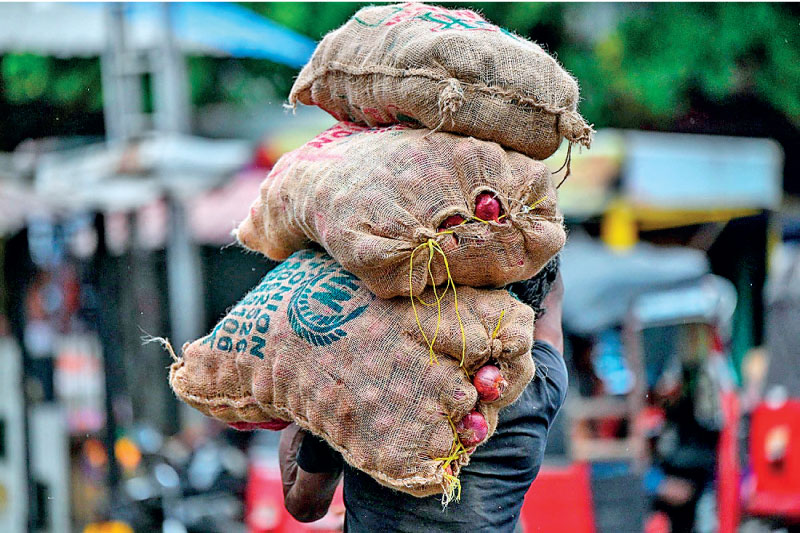Sunday Nov 16, 2025
Sunday Nov 16, 2025
Monday, 14 August 2023 00:18 - - {{hitsCtrl.values.hits}}

Sri Lankan banks hold most of the Government’s domestic debt – Pic credit: Getty Images

A labourer carries onions at a market in Colombo on 4 July. In late June, Sri Lanka released its proposed domestic debt restructure deal – Pic credit: Ishara S. Kodikara/AFP via Getty Images
|
By Mariza Cooray and Roland Rajah
www.lowyinstitute.org: Sri Lanka today exists in a no man’s land between debt restructure and default. In late June, the Government released its proposed domestic debt restructure deal, which in turn also signals the terms it will seek from its external creditors.
Domestic debt accounts for about half of the country’s total debt stock and external creditors insist this must be included in any debt restructuring.
The Government’s proposal would cut deep into the domestic economy and Sri Lankan society, yet ultimately asks too little from its external creditors. The net result will be far from enough to alleviate the economic and humanitarian crisis playing out. At best, it will leave Sri Lanka teetering on the edge for the foreseeable future, that is until the next economic shock inevitably comes along.
The proposed domestic debt restructure would knock off about 1.5% of GDP in upcoming annual Government debt servicing payments. The Government says this is needed to meet the debt restructuring targets set by the International Monetary Fund. It is, however, a minor contribution towards the roughly 15% of GDP reduction in annual payments Sri Lanka needs, according to the IMF.
Yet there is probably not much more the Government can do. The reason is that domestic debt is fundamentally different to external debt when it comes to restructuring. Imposing losses on domestic creditors essentially imposes losses on the country itself.
Sri Lankan banks hold most of the Government’s domestic debt and bank financial health is already under enormous strain from the ongoing economic crisis. Imposing further large losses on the banks would only exacerbate the situation – hampering credit extension, undermining recovery, and potentially triggering a banking crisis. Or it would require the Government to recapitalise the banks, mitigating the value of reducing the Government’s financing needs in the first place.
The Government, therefore, seems to be concentrating the burden of restructuring its rupee-denominated debt on the country’s superannuation funds. Notionally, the super funds have until 11 August to decide whether they will participate. There is little choice in practice, though, with the Government saying that failure to accept would see the funds hit with a more than doubling of existing tax rates to 30%.
Imposing losses on the super funds will hit many ordinary Sri Lankans who are already paying dearly for the crisis. Inflation, for instance, reached nearly 75% in September last year, eviscerating the real value of both household incomes and savings, much of which are held in the super funds for the working class.
Undermining households further will only weaken Sri Lanka’s prospects for economic recovery. It will also make the path to sustainable debt servicing even harder – once again demonstrating the fundamental limits of what can usefully be achieved through domestic debt restructuring.
Why restructure domestic debt at all then?
The main reason seems to be that Sri Lanka’s international private creditors have insisted on it. The value of the domestic debt restructuring is thus more about appeasing international creditors in an attempt to unlock the external debt relief that Sri Lanka truly needs than it is about actually contributing to reducing the debt burden itself.
Another issue is that some of Sri Lanka’s domestic law debt is in the form of US dollar bonds held by both domestic banks and foreign private creditors. These need to be restructured on similar terms to Sri Lanka’s international sovereign bonds. But on this front, the proposed restructuring looks light. In part, this again reflects the need to limit further damage to domestic banks. However, it also seems to reflect low expectations for Sri Lanka’s ability to achieve a prompt and meaningful restructuring with its external creditors.
The problems are readily visible in the debt sustainability assessment and targets set by the IMF program to begin with. Under those targets, government debt would still be more than 100% of GDP in five years, and 95% of GDP in a decade. Instead of total debt, the IMF has put the emphasis on reducing debt servicing payments over the coming years to less than 14% of GDP, itself still a very high level. Yet, as Brad Setser of the Council on Foreign Relations notes, in doing so the IMF may be setting Sri Lanka up for failure.
The IMF program document itself virtually admits defeat, stating that “even after a successful program and debt restructuring, debt risks will remain high for many years”. The IMF notes that the reasoning behind its (soft) debt restructuring targets is to ensure a “higher likelihood for debt reduction”. This would seem to reflect strong concerns that asking for more would increase the risk of a creditor holdout situation, which was the case in Suriname, or an otherwise drawn-out process, as in Zambia.
Yet even with the lighter terms currently proposed, the process is dragging out. A separate negotiation process between the Government of Sri Lanka and China seems to have left more traditional creditors understandably nervous.
Failure to secure a restructuring deal with external creditors will prevent Sri Lanka from receiving its next much-needed financing tranche of around $ 330 million from the IMF. Without this, the country’s debt crisis will only deepen, and even more debt relief could ultimately be required.
It is in their own interests for Sri Lanka’s external creditors to do far more and much faster. Restructuring domestic debt is a distraction and itself cannot do enough to resolve the crisis.
|
(Source: https://www.lowyinstitute.org/the-interpreter/sri-lanka-s-deep-debt-bind)
(Mariza Cooray is a Research Fellow and senior economist in the Lowy Institute’s Indo-Pacific Development Centre. She has a decade of experience living and working in the Pacific and Indonesia for the Department of Foreign Affairs and Trade, USAID and the Asian Development Bank. She has also worked as a Country Economist for the World Bank in Sri Lanka and began her career in international development in Sri Lanka. Her research interests include public finance, debt management and crisis, poverty and inequality, growth and emerging markets. Mariza has postgraduate qualifications in Mathematics from the Australian National University, a Master of Science in Development Economics from the London School of Economics where she was an LSE PJD Wiles Scholar, and a Bachelor of Arts in Economics from Wilson College in Pennsylvania in the United States. She speaks Sinhalese and Spanish and understands Mandarin.)
(Roland Rajah is Director of the Indo-Pacific Development Centre, a dedicated policy research centre within the Lowy Institute. The Centre is committed to producing fresh policy insights and ideas on the most pressing economic development challenges facing the Indo-Pacific region — principally focusing on the emerging and developing economies of Southeast Asia, the Pacific Islands and South Asia. He also serves as the Lowy Institute’s Lead Economist, a position he has held since joining the Institute in 2017. Roland directs the overall work program of the Indo-Pacific Development Centre across its key thematic pillars of post-COVID growth and development, globalisation and regional integration, climate change and development, technology and digital economy, aid and development finance, and geoeconomics. The Centre also houses the Lowy Institute Pacific Aid Map project, which provides the world’s most comprehensive data tracking of all official aid and other development finance flows to the Pacific Islands. A development economist by background, Roland has extensive experience working across both emerging Asia and the small island developing states of the Pacific. He has previously worked for the Asian Development Bank, Australian Department of Foreign Affairs and Trade, the Australian Agency for International Development (AusAID), and the Reserve Bank of Australia. Roland holds a master’s degree in economics from the Australian National University, where he was awarded the Helen Hughes Prize in International and Development Economics. He also serves on the board of the Cambodia Development Resource Institute, one of Southeast Asia’s leading independent policy research think tanks.)